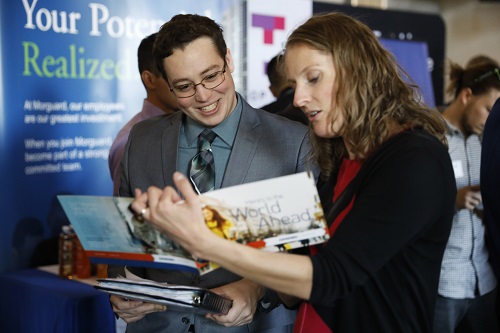Early Bird
Classroom and career connections
Thirsty for a Strong Instructional Practice?
March 14, 2019
 Thirsty for a Strong Instructional Practice?
Thirsty for a Strong Instructional Practice?
As an institutional priority, career development generally ebbs and flows between being core to the student experience to an auxiliary service that students access just before graduation. While polishing a resume and creating a compelling cover letter will certainly remain an important part of the job search and, therefore, campus career services, the way in which students align their entire undergraduate experience to their career trajectories is increasingly important. Connecting the classroom experience to career ambitions for students begins at, or before, orientation and persists each semester, culminating at graduation.
Without question, students bring to Metropolitan State University of Denver their unique strengths and ambitions. Some have extensive professional experience while others have not yet held their first job. Similarly, some students are steadfast in their career goals and others are still exploring majors. Regardless of where they are in this process, they each have an opportunity to further articulate and prepare for their career path in each course and with each experience.
Take a SIP of This: classroom and career connections
Ultimately, career preparedness is a social-justice issue, particularly at a University that expands access and opportunity for historically marginalized students. When closely connected to academic advising, career education can serve as a retention tool and lever for economic mobility. However, to frame career development in this manner, we must be intentional in our approach. Historically, career services have lacked true integration in the student experience and have for the most part, been available primarily to those who seek it out. Faculty and academic units have prioritized career readiness in a variety of approaches, including a specific course with learning outcomes, hosting alumni panels or propping up a program-specific mentorship program.
The “place” for career development is a commonly debated topic within higher education and the academe. The organizational structures will continue to shift, expand and retract to adjust to institutional needs and priorities and technological advances. No matter the structure or academic home, students prepare for their respective careers in the classroom and through co-curricular programming.
With tightknit collaborations, students can lean more readily on a structure that supports their career path. The shift from making career services simply available to students to a full commitment that will support every student’s career preparedness is bound to shake things up and requires a paradigm shift of sorts. We, like our students, are setting ambitious goals to engage industry leaders, look internally to assess our existing structures and scale our programs to affect workforce development and career readiness for all of our students. In short, we strive to reach each student where they are. We know that with a diverse student body such as ours, we must not only consider the complexity of students’ lives but design accordingly. Faculty often utilize a variety of strategies to integrate career education into their course curriculum. We’d love to learn more about what methods instructors are using here at MSU Denver. Please share your insights and approaches with the Classroom to Career Hub!
Career Integration:
- Consider an assignment directly related to the job search. Students can explore job dashboards (LinkedIn, Indeed, Glassdoor, MSU Career Link) to find aspirational positions and develop a tailored résumé and compelling cover letter. Explore how Vault can be utilized in your classroom.
- Including a panel discussion with alumni or other community members is a great way for students to connect directly with professionals who have experience in respective career fields.
- Students can practice networking skills with their classmates and instructors. The concept of networking can be anxiety-provoking to many of us. Just like other skills, practice helps. Creating and practicing an “elevator pitch” with peers is a great way to practice.
- Encourage students to share with one another their career ambitions and pursuits.
- Internships are a wonderful way to apply learning to a hands-on experience.
- A “flash talk” assignment can help students articulate course concepts into a quick and practical response to a standard interview question.
- Refer the student to the C2Hub for:
- Mock interviews with peers, industry leaders, alumni or career-services staff. These connections help students become more comfortable speaking about their strengths while developing an interview strategy.
- With technological advances, the first-round interview is shifting. While phone screenings will continue to be common, so too will the video conference. In the coming months, MSU Denver will have additional resources to expand these opportunities for faculty and staff. Keep an eye out for an announcement with additional resources!
- The National Association of Colleges and Employers has defined eight competencies to help define career readiness. Articulate how your course addresses a few competency areas:
- Critical thinking/problem solving
- Oral/written communications
- Teamwork/collaboration
- Digital technology
- Leadership
- Professionalism/work ethic
- Career management
- Global/intercultural fluency
Still thirsty? Take another SIP of classroom and career connections
- Podany, J. (2018). Social Innovation for the Future of College Career Education (Part 1): The Big Problem.
- Podany, J. (2018). Social Innovates for the Future of College Career Education (Part 2): Lessons From Early Social Innovators.
- National Association of Colleges and Employers Career Readiness Defined.
- Want to Enhance Humanities Career Outcomes? Engage the Faculty. The job of preparing students for the workplace can’t be left to career-services offices alone. Inside Higher Ed.
- Reinventing the Career Center Colleges — and companies — are trying to help students design their futures Chronicle of Higher Ed.
Visit the Well at for more great ideas and resources for Strong Instructional Practices in your higher-education classroom!
Topics: Academics
Edit this page